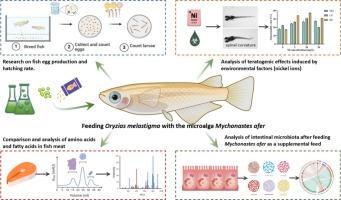Effects of the nervonic acid-rich microalga Mychonastes afer on the growth and reproductive processes of Oryzias melastigma
IF 4.5
2区 生物学
Q1 BIOTECHNOLOGY & APPLIED MICROBIOLOGY
Algal Research-Biomass Biofuels and Bioproducts
Pub Date : 2025-09-15
DOI:10.1016/j.algal.2025.104305
引用次数: 0
Abstract
The aquaculture industry's expansion necessitates sustainable strategies to enhance aquatic animal health and production. This study evaluates Mychonastes afer—a microalga rich in nervonic acid—as a novel aquafeed supplement for marine medaka (Oryzias melastigma), focusing on growth, intestinal health, and reproduction. Fish fed high-concentration M. afer exhibited 10.04 % polyunsaturated fatty acid content, surpassing the 8.80 % in controls, alongside improved growth metrics. While M. afer enhanced gut microbial diversity, its primary reproductive benefits included an 8.86–9.33 % higher embryo fertilization rate compared to C. sorokiniana and blank groups. Under nickel exposure (5–20 mg/L), larvae from M. afer-supplemented environments demonstrated superior resilience: at 10 mg/L Ni, hatching rates in M. afer and C. sorokiniana groups remained stable, while controls dropped from 73 % to 52.84 %. Abnormalities were lowest in M. afer larvae (26 % vs. 30–37 % in other groups), with a 1-day delay in irreversible developmental damage. These findings highlight M. afer's ability to address nutritional gaps in conventional feeds, promoting growth, stress tolerance, and reproductive success in medaka. Nervonic acid in M. afer may further mitigate neurotoxicity and support neural regeneration, underscoring its potential as an eco-friendly aquafeed alternative to enhance aquaculture productivity under heavy metal stress.

富神经酸微藻对黑米藻生长和繁殖过程的影响
水产养殖业的扩张需要可持续战略,以加强水生动物的健康和生产。本研究评估了一种富含神经酸的微藻Mychonastes after作为海洋medaka (Oryzias melastigma)的新型水产饲料补充剂,重点关注其生长、肠道健康和繁殖。饲喂高浓度M. M.后的鱼多不饱和脂肪酸含量为10.04%,超过对照组的8.80%,同时生长指标也有所改善。在提高肠道微生物多样性的同时,其主要生殖效益包括胚胎受精率比空白组高8.86 ~ 9.33%。在镍浓度为5 ~ 20 mg/L的环境中,经镍补充后的M. after和C. sorokiniana的幼虫表现出较强的恢复能力:在镍浓度为10 mg/L时,M. after和C. sorokiniana的孵化率保持稳定,而对照组的孵化率从73%下降到52.84%。M.幼虫后的异常最低(26%,而其他组为30 - 37%),不可逆发育损伤延迟1天。这些发现突出了M. after能够解决传统饲料中的营养缺口,促进medaka的生长、耐受性和繁殖成功。黄颡鱼中的神经酸可能进一步减轻神经毒性和支持神经再生,强调其作为一种生态友好型水产饲料替代品的潜力,以提高重金属胁迫下水产养殖的生产力。
本文章由计算机程序翻译,如有差异,请以英文原文为准。
求助全文
约1分钟内获得全文
求助全文
来源期刊

Algal Research-Biomass Biofuels and Bioproducts
BIOTECHNOLOGY & APPLIED MICROBIOLOGY-
CiteScore
9.40
自引率
7.80%
发文量
332
期刊介绍:
Algal Research is an international phycology journal covering all areas of emerging technologies in algae biology, biomass production, cultivation, harvesting, extraction, bioproducts, biorefinery, engineering, and econometrics. Algae is defined to include cyanobacteria, microalgae, and protists and symbionts of interest in biotechnology. The journal publishes original research and reviews for the following scope: algal biology, including but not exclusive to: phylogeny, biodiversity, molecular traits, metabolic regulation, and genetic engineering, algal cultivation, e.g. phototrophic systems, heterotrophic systems, and mixotrophic systems, algal harvesting and extraction systems, biotechnology to convert algal biomass and components into biofuels and bioproducts, e.g., nutraceuticals, pharmaceuticals, animal feed, plastics, etc. algal products and their economic assessment
 求助内容:
求助内容: 应助结果提醒方式:
应助结果提醒方式:


